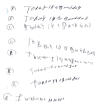Major Cognitive Changes and Micrographia following Globus Pallidus Infarct
- PMID: 25478259
- PMCID: PMC4247961
- DOI: 10.1155/2014/252486
Major Cognitive Changes and Micrographia following Globus Pallidus Infarct
Abstract
Importance. Globus pallidus (GP) lesions are well known to cause motor deficits but are less commonly-and perhaps not conclusively-associated with cognitive problems. Observations. We present a 45-year-old male with no significant neurological or psychological problems who after suffering a GP infarct was subsequently found to have substantial cognitive problems and micrographia. Formal neuropsychological testing was not possible due to lack of patient follow-up. Conclusions and Relevance. Despite the conflicting literature on the association of GP lesions and cognitive deficits, our patient demonstrated significant neuropsychological changes following his stroke. In addition, evidence of micrographia likely adds to the literature on the localization of this finding. Our case thus suggests that neuropsychological testing may be beneficial after GP strokes.
Figures
Similar articles
-
Parkinsonism following bilateral lesions of the globus pallidus: performance on a variety of motor tasks shows similarities with Parkinson's disease.J Neurol Neurosurg Psychiatry. 2005 Apr;76(4):482-90. doi: 10.1136/jnnp.2003.020800. J Neurol Neurosurg Psychiatry. 2005. PMID: 15774432 Free PMC article.
-
Unilateral lesions of the globus pallidus: report of four patients presenting with focal or segmental dystonia.J Neurol Neurosurg Psychiatry. 2000 Oct;69(4):494-8. doi: 10.1136/jnnp.69.4.494. J Neurol Neurosurg Psychiatry. 2000. PMID: 10990510 Free PMC article.
-
Lower limb monochorea from a globus pallidus infarct.J Clin Neurosci. 2014 Aug;21(8):1455-7. doi: 10.1016/j.jocn.2013.10.038. Epub 2014 Feb 3. J Clin Neurosci. 2014. PMID: 24602360
-
Bilateral contemporaneous posteroventral pallidotomy for the treatment of Parkinson's disease: neuropsychological and neurological side effects. Report of four cases and review of the literature.J Neurosurg. 1999 Aug;91(2):313-21. doi: 10.3171/jns.1999.91.2.0313. J Neurosurg. 1999. PMID: 10433321 Review.
-
Roles of Multiple Globus Pallidus Territories of Monkeys and Humans in Motivation, Cognition and Action: An Anatomical, Physiological and Pathophysiological Review.Front Neuroanat. 2017 Apr 10;11:30. doi: 10.3389/fnana.2017.00030. eCollection 2017. Front Neuroanat. 2017. PMID: 28442999 Free PMC article. Review.
Cited by
-
Heat Stroke Lesions in the Globus Pallidus.Intern Med. 2020 Apr 1;59(7):1015-1016. doi: 10.2169/internalmedicine.3317-19. Epub 2020 Jan 9. Intern Med. 2020. PMID: 31915313 Free PMC article. No abstract available.
-
Long-term brain structural magnetic resonance imaging and cognitive functioning in children treated for acute lymphoblastic leukemia with high-dose methotrexate chemotherapy alone or combined with CNS radiotherapy at reduced total dose to 12 Gy.Neuroradiology. 2017 Feb;59(2):147-156. doi: 10.1007/s00234-016-1777-8. Epub 2017 Jan 10. Neuroradiology. 2017. PMID: 28074235 Free PMC article.
-
Increased [18F]Fluorodeoxyglucose Uptake in the Left Pallidum in Military Veterans with Blast-Related Mild Traumatic Brain Injury: Potential as an Imaging Biomarker and Mediation with Executive Dysfunction and Cognitive Impairment.J Neurotrauma. 2024 Jul;41(13-14):1578-1596. doi: 10.1089/neu.2023.0429. Epub 2024 May 8. J Neurotrauma. 2024. PMID: 38661540 Free PMC article.
References
-
- Münchau A., Mathen D., Cox T., Quinn N. P., Marsden C. D., Bhatia K. P. Unilateral lesions of the globus pallidus: report of four patients presenting with focal or segmental dystonia. Journal of Neurology, Neurosurgery & Psychiatry. 2000;69(4):494–498. doi: 10.1136/jnnp.69.4.494. - DOI - PMC - PubMed
-
- Ghika J., Ghika-Schmid F., Fankhauser H., Assal G., Vingerhoets F., Albanese A., Bogousslavsky J., Favre J. Bilateral contemporaneous posteroventral pallidotomy for the treatment of Parkinson's disease: Neuropsychological and neurological side effects: report of four cases and review of the literature. Journal of Neurosurgery. 1999;91(2):313–321. doi: 10.3171/jns.1999.91.2.0313. - DOI - PubMed
-
- Lombardi W. J., Gross R. E., Trepanier L. L., Lang A. E., Lozano A. M., Saint-Cyr J. A. Relationship of lesion location to cognitive outcome following microelectrode-guided pallidotomy for Parkinson's disease. Support for the existence of cognitive circuits in the human pallidum. Brain. 2000;123(4):746–758. doi: 10.1093/brain/123.4.746. - DOI - PubMed
LinkOut - more resources
Full Text Sources
Other Literature Sources



